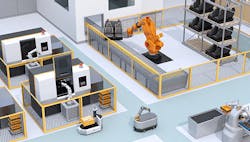Over the past few years, the maturity of mobile robots that can autonomously move around inside a building or outdoors and avoid obstacles has created an explosion of new companies and solutions across different industry segments.
The epicenter of this explosion has been in the supply-chain sector, including companies performing intralogistics tasks, third-party logistics (3PLs), retail sector for e-commerce and store replenishment tasks and even last-mile delivery.
Thanks to improvements in computing power, artificial intelligence algorithms, machine vision and lower-cost LiDAR and other sensors, autonomous mobile robots (AMRs) that can move more efficiently around a warehouse have been adopted at higher rates than their older cousins, automated guided vehicles (AGVs).
AMRs have allowed organizations to improve their fulfillment and order-picking operations, especially in the wake of increased consumer demand and larger labor shortages for warehouse workers.
Besides material-handling AMRs, other types of AMRs such as robotic floor cleaners can be seen in warehouses and factories helping to automate floor cleaning. And it’s not just AMRs that are entering warehouses; larger industrial robot arms augmented with cameras for machine vision and smaller collaborative robots that can work side-by-side with humans are also assisting with tasks, such as the loading and unloading of pallets, or the picking, placing and packing of materials for order fulfillment or product kitting.
Yet each of these robotics deployments is in its own bubble, while you may see a company with two different robots in a factory or warehouse, the robots are usually in isolated sections and are certainly not communicating with each other or performing tasks together. Not yet, at least.
Larger companies, such as major 3PLs and retailers, are leading the way in terms of orchestrating the operations of multiple robots. Companies such as DHL, FedEx and Walmart, as well as consumer packaged goods (CPG) giants such as Procter & Gamble, are among the companies exploring how robots can interact with each other for the benefit of the entire operation. While we are still in the very early stages, this is rapidly becoming a prerequisite, and robot developers would be well-served paying attention to changing customer expectations.
Typically, the adoption of robotics for a company goes through several stages, which can take weeks, months or even years.
- Robot developers approach end users with a single-robot proof of concept (PoC) to demonstrate the feasibility of a robot performing a particular task—moving goods, picking items, loading pallets.
- Once the PoC is completed, a pilot project with multiple robots performing the same task, typically within a single site, begins to prove a return on investment for a customer.
- If the pilot is successful, a customer then usually moves to an initial scaling, in which multiple sites are chosen and the robots can work in different warehouses, although this is often limited to a specific region.
- Growth beyond this initial scaling can then include expanding to other tasks and bringing different types of robots, such as tugger robots for pallets or goods-to-person robots for picking. At this point, other robots such as floor-cleaning robots and inventory scanning robots may be deployed, adding to the number of robots for a single site.
- The final stage would be a fully orchestrated warehouse, in which the work of all of the robots, both in a single facility as well as multiple sites, can be monitored, managed and maintained through a single, integrated platform.
The reality is that most companies are still in these early stages, such as a single deployment or even a PoC or pilot project. There are a few obstacles, such as lack of interoperability standards and communications between robots and other software, that prevent companies from taking the next step.
When it comes to true interoperability, we are still at the “Hello, world” stage. Some emerging interoperability standards, such as the MassRobotics AMR Interoperability Standard and the European VDA-5050 standard, are evolving quickly, although at the moment they are limited in scope and functionality. Projects where one robot type—an AMR—can talk with another robot type—robot arm—are limited between the two robot companies exploring a solution. Additional projects include integration of a robot fleet with a company’s warehouse management or execution software, or potentially even an enterprise-resource-planning (ERP) system. This requires another software layer and system-integration work with specific vendors of the robots and software platform.
The ultimate goal is not just interoperability but orchestration of an entire end-to-end operation, giving robot operators the ability to check, monitor, control and react to every robot within their footprint.
Enabling this will require that companies explore and utilize cloud computing infrastructures in order to effectively deploy, monitor, control and optimize robot operations. Non-profit organizations such as the Robot Operations Group (www.robops.org) are helping to share the best practices for scaling robot deployments from five to 5,000 and beyond. ABI Research estimates robot-related services powered by cloud-computing services will reach $157.8 billion in annual revenue by 2030.
Companies looking to deploy such architecture will need to be vendor-agnostic, providing a single pane of glass for operations teams that also include API hooks into other important platforms and systems, such as a warehouse management system (WMS), warehouse control system (WCS), manufacturing control system (MCS) or ERP software.
A highly scalable, flexible and efficient cloud infrastructure is agnostic to the specific applications that run on it, while adapting to specific needs. This will lead to the adoption of the concept of “software-defined X”, in which companies will develop physical robots for specific tasks, while allowing cloud software to control its operations. Companies will use a software layer that sits between internal systems and robots to introduce automation into existing physical processes without having to hire an army of roboticists or engineers.
Also read: Robots move interoperability to the forefront
An added bonus to this way of thinking is that orchestration will also enable better efficiency when integrating robots into an existing WMS or ERP system.
This will allow companies to choose any robot and any software platform and connect everything through a cloud-based infrastructure system. It’s not science fiction; this is already being embraced by the most innovative companies.
Companies that choose not to embrace this model will soon be left behind. In order for the industry as a whole to continue to grow exponentially, we will need to connect all these islands through the bridges of interoperability. Only then will we be able to get closer to the efficiencies and benefits of true robotic orchestration.
Florian Pestoni is CEO of InOrbit. Contact him at [email protected].
About the Author
Florian Pestoni
InOrbit
Florian Pestoni, founder and CEO of InOrbit.AI, will present “The Future-Proof Supply Chain: AI-Powered, Data-Driven and Software-Defined” at 1:30 pm on May 13 during A3's Automate 2025 in Detroit. His presentation will include an explanation of InOrbit Space Intelligence, a software platform designed to leverage the power of physical AI, robotics and system integrations to deliver a holistic view of automation.
Pestoni is an accomplished business leader and author, with a track record of bringing innovative products to market. As founder and CEO of InOrbit.AI, he leads product strategy, fundraising and go-to-market activities. Since starting InOrbit, Pestoni has become a key voice in the robotics industry, with a large following on social media. He is passionate about raising awareness around the growing role of robotics and artificial intelligence in people’s lives.
InOrbit.AI is focused on AI-powered robot orchestration, helping enterprise customers across industries efficiently manage smart robots at scale. Physical AI is accelerating growth in robotics as a new autonomous workforce, and InOrbit provides the common platform to make robots work better together. InOrbit Space Intelligence integrates spatial and operational data from every robot with a semantic environment model and line-of-business data, such as orders and inventory, to execute physical business processes efficiently in the real world.
Pestoni also co-founded the Robot Operations Group, a community-led organization with more than 300 members that organizes regular meetings and global conferences to develop and share the best practices for robot operations. In addition, Pestoni represents the United States in the ISO (International Organization Standardization) initiative to create a common mechanism for mobile robot communication; he is also leading the working group of the ARME Interoperability Initiative defining common mapping semantics and practices.
Under Pestoni’s leadership, the InOrbit Robot Space has become a hub for robotics and community engagement in the heart of Silicon Valley. Besides being a live showcase of a global ecosystem of InOrbit partners who contribute their robots to show how they can work together, the Robot Space hosts events for industry leaders, entrepreneurs, investors, academics and students who are exposed to the latest AI and robotics technologies.
Pestoni holds an MSEE from the University of Buenos Aires and an MBA from UC Berkeley. Prior to InOrbit, he worked at technology companies such as Microsoft, Facebook and Adobe, as well as startups and research labs. He holds more than 30 patents, with work on diverse areas such as image processing, cryptography and embedded systems. Contact him at [email protected].
Other articles by Florian Pestoni include:

Leaders relevant to this article:


